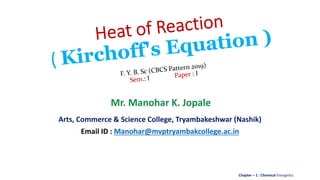
Chemical energetics 05
- 1. Arts, Commerce & Science College, Tryambakeshwar (Nashik) Email ID : Manohar@mvptryambakcollege.ac.in Chapter – 1 : Chemical Energetics
- 2. 1.5 Variation of Heat of Reaction with Temperature (Kirchoff's Equation] : • Heat evolved or absorbed in a reaction depends upon the temperature at which it is carried out. The relationship showing the variation of the heat of reaction with temperature was given by Kirchoff in 1856 and is stated as, • “ The change in the heat of reaction at constant pressure for every degree of temperature is equal to the change in the heat capacity at constant pressure, accompanying the reaction”. It can be derived as under. Consider the general reaction. Chapter – 1 : Chemical Energetics
- 3. • Case 1 When the reaction is carried out at constant pressure : • Suppose the heat of reaction (heat evolved) at temperature T1 = ∆H1, and the heat of reaction (heat evolved) at temperature T2 = ∆H2 (Fig 1.5) • Starting from A at temperature T1, we can reach B at temperature T2 by two different routes • Route I : We perform the reaction at temperature T, to obtain B at the same temperature and then heathis up to the temperature T2 • Then Heat evolved in the first stage = ∆H1 • Heat absorbed in the II stage = (Cp)B (T2 – T1) • Where (Cp)B is is the average molar heat capacity of the products. • .: Net heat evolved = ∆H1 - (CP)B (T2 – T1) Chapter – 1 : Chemical Energetics
- 4. Chapter – 1 : Chemical Energetics Fig. Kirchoff’s Equation for reaction
- 5. • Route II : • We first heat up the reactants to the temperature T2 and then perform the reaction to give the products at the same temperature. Then if (Cp)A is the average molar heat capacity of the reactant A, • Heat absorbed in the first stage = ((Cp)A (T2-T1) • Heat evolved in the second stage = ∆H2 • .: Net heat evolved = ∆H2 -(CP)A (T2-T1) • Initial and the final states are the same in both the cases. Therefore, by law of conservation of energy, we must have. Net heat evolved by route I = Net heat evolved by route II i.e. ∆H2 -(CP)A (T2-T1) = ∆H1 - (CP)B (T2 – T1) Or ∆H2−− ∆H1 T2 – T1 = ∆ CP Chapter – 1 : Chemical Energetics
- 6. • When reaction is carried out at constant volume : We have the We have the thermodynamic relation. ∆ H = ∆ U + P ∆ V Under condition of constant volume. ∆V = 0 i.e. ∆ H = ∆ U Hence equation derived above takes the form ∆U2−− ∆U1 T2 – T1 = ∆ CV Where CV is molar heat capacity at constant Volume • Thus Kirchoff's equation may also be expressed as follows: “The change in the heat of reaction at constant volume for every degree change of temperature is equal to the change in the heat capacity at constant volume, accompanying the reaction”. Chapter – 1 : Chemical Energetics
- 7. Problem 1.12 • 1.12 : Calculate the heat of formation of H2O (l) at 383 K if ∆H for the reaction H2 (g)+ O2 (g) H2O (l) at 298 K is - 298.06 kJ. The average values of heat capacities between the for H2 (g), O2 (g) and H2O (l) are 27.61, 29.50 and 75.31 JK-1mol-1 respectively. Solution : H2 (g)+ O2 (g) H2O (l) Formula: ∆CP = CP (H2O) – (H2) - 1 2 (O2) = 75.31 -27.61- 1 2 29.50 Chapter – 1 : Chemical Energetics
- 8. = 32.95 JK-1mol-1 = 32.95 x 10-3 kJK-1mol-1 Applying Kirchoff’s equation, ∆H2−− ∆H1 T2 – T1 = ∆ CP substituting values, we have ∆H2−(−298.06) 383 – = 32.95 x 10-3 ∆H2 + 298.06 𝟖𝟓 = 32.95 x 10-3 ∆H2 + 298.06 = 85 x 32.95 x 10-3 ∆H2 = 2.80-298.06 ∆H2 = -295.26 kJ Chapter – 1 : Chemical Energetics
- 9. Problem 1.13 1.13 : Calculate the heat of formation of HCl at 348 K from the following data : 𝟏 𝟐 H2 (g) + 𝟏 𝟐 Cl2 (g) HCl (g) ∆H0 298 =-92300 J • The mean heat capacities over this temperature range are H2 (g); CP = 28.53 JK-1mol-1 Cl2 (g); CP = 32.26 JK-1mol-1 HCI (g); CP = 28.49 JK-1mol-1 • Solution : The reaction under consideration is 𝟏 𝟐 H2 (g) + 𝟏 𝟐 Cl2 (g) HCl (g) Chapter – 1 : Chemical Energetics
- 10. • For this reaction, ∆CP of reaction = CP (HCl) – 1 2 CP(H2) - 1 2 CP(Cl2) = 29.49 - 1 2 (28.53) - 1 2 (32.26) = -1.91 JK-1 mol -1 It is given that, ∆H1 = -92300 J, T1 = 298 K , ∆H2 ∆H2−− ∆H1 T2 – T1 = ∆ CP ∆H2 = ∆H1 + ∆ CP (T2 – T1) = -92300 + (-1.91) x ( 348 – 298 ) = -92300 - 95.5 ∆H2 = -92395.5 J Chapter – 1 : Chemical Energetics